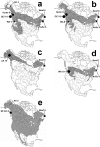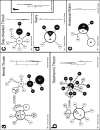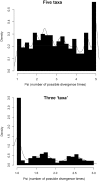How migratory thrushes conquered northern North America: a comparative phylogeography approach
- PMID: 24255819
- PMCID: PMC3828608
- DOI: 10.7717/peerj.206
How migratory thrushes conquered northern North America: a comparative phylogeography approach
Abstract
Five species of migratory thrushes (Turdidae) occupy a transcontinental distribution across northern North America. They have largely overlapping breeding ranges, relatively similar ecological niches, and mutualistic relationships with northern woodland communities as insectivores and seed-dispersing frugivores. As an assemblage of ecologically similar species, and given other vertebrate studies, we predicted a shared pattern of genetic divergence among these species between their eastern and western populations, and also that the timing of the coalescent events might be similar and coincident with historical glacial events. To determine how these five lineages effectively established transcontinental distributions, we used mitochondrial cytochrome b sequences to assess genetic structure and lineage coalescence from populations on each side of the continent. Two general patterns occur. Hermit and Swainson's thrushes (Catharus guttatus and C. ustulatus) have relatively deep divergences between eastern and western phylogroups, probably reflecting shared historic vicariance. The Veery (C. fuscescens), Gray-cheeked Thrush (C. minimus), and American Robin (Turdus migratorius) have relatively shallow divergences between eastern and western populations. However, coalescent and approximate Bayesian computational analyses indicated that among all species as many as five transcontinental divergence events occurred. Divergence within both Hermit and Swainson's thrushes resembled the divergence between Gray-cheeked Thrushes and Veeries and probably occurred during a similar time period. Despite these species' ecological similarities, the assemblage exhibits heterogeneity at the species level in how they came to occupy transcontinental northern North America but two general continental patterns at an among-species organizational level, likely related to lineage age.
Keywords: Community assembly; Community phylogeography; Ecological evolutionary genetics; Ecology; Phylogeography; Population genetics.
Figures




Similar articles
-
Comparative Population Genomics of Cryptic Speciation and Adaptive Divergence in Bicknell's and Gray-Cheeked Thrushes (Aves: Catharus bicknelli and Catharus minimus).Genome Biol Evol. 2022 Jan 4;14(1):evab255. doi: 10.1093/gbe/evab255. Genome Biol Evol. 2022. PMID: 34999784 Free PMC article.
-
The effects of diet-shifting from invertebrates towards fruit on the condition of autumn-migrant Catharus thrushes.Oecologia. 2024 Mar;204(3):559-573. doi: 10.1007/s00442-024-05511-4. Epub 2024 Feb 16. Oecologia. 2024. PMID: 38363323
-
Division within the North American boreal forest: Ecological niche divergence between the Bicknell's Thrush (Catharus bicknelli) and Gray-cheeked Thrush (C. minimus).Ecol Evol. 2017 Jun 8;7(14):5285-5295. doi: 10.1002/ece3.3080. eCollection 2017 Jul. Ecol Evol. 2017. PMID: 28770067 Free PMC article.
-
Speciation, gene flow, and seasonal migration in Catharus thrushes (Aves:Turdidae).Mol Phylogenet Evol. 2019 Oct;139:106564. doi: 10.1016/j.ympev.2019.106564. Epub 2019 Jul 19. Mol Phylogenet Evol. 2019. PMID: 31330265
-
Revisiting the comparative phylogeography of unglaciated eastern North America: 15 years of patterns and progress.Ecol Evol. 2022 Apr 19;12(4):e8827. doi: 10.1002/ece3.8827. eCollection 2022 Apr. Ecol Evol. 2022. PMID: 35475178 Free PMC article. Review.
Cited by
-
DNA barcodes of birds from northern Colombia.Biodivers Data J. 2021 May 21;9:e64842. doi: 10.3897/BDJ.9.e64842. eCollection 2021. Biodivers Data J. 2021. PMID: 34084068 Free PMC article.
-
Seasonally migratory songbirds have different historic population size characteristics than resident relatives.Elife. 2025 May 12;12:RP90848. doi: 10.7554/eLife.90848. Elife. 2025. PMID: 40353828 Free PMC article.
-
Comparative Population Genomics of Cryptic Speciation and Adaptive Divergence in Bicknell's and Gray-Cheeked Thrushes (Aves: Catharus bicknelli and Catharus minimus).Genome Biol Evol. 2022 Jan 4;14(1):evab255. doi: 10.1093/gbe/evab255. Genome Biol Evol. 2022. PMID: 34999784 Free PMC article.
-
The conquering of North America: dated phylogenetic and biogeographic inference of migratory behavior in bee hummingbirds.BMC Evol Biol. 2017 Jun 5;17(1):126. doi: 10.1186/s12862-017-0980-5. BMC Evol Biol. 2017. PMID: 28583078 Free PMC article.
References
-
- American Ornithologist’s Union (AOU) Check-list of North American birds. 7th ed. Washington, DC: American Ornithologist’s Union; 1998.
-
- Andrew RL, Bernatchez L, Bonin A, Buerkle CA, Carstens BC, Emerson BC, Garant D, Giraud T, Kane NC, Rogers SM, Slate J, Smith H, Sork VL, Stone GN, Vines TH, Waits L, Widmer A, Rieseberg LH. A road map for molecular ecology. Molecular Ecology. 2013;22:2605–2626. doi: 10.1111/mec.12319. - DOI - PubMed
-
- Arbogast BS. Mitochondrial DNA phylogeography of the New World flying squirrels (Glaucomys): implication for Pleistocene biogeography. Journal of Mammalogy. 1999;80:142–155. doi: 10.2307/1383215. - DOI
LinkOut - more resources
Full Text Sources
Other Literature Sources
Research Materials

